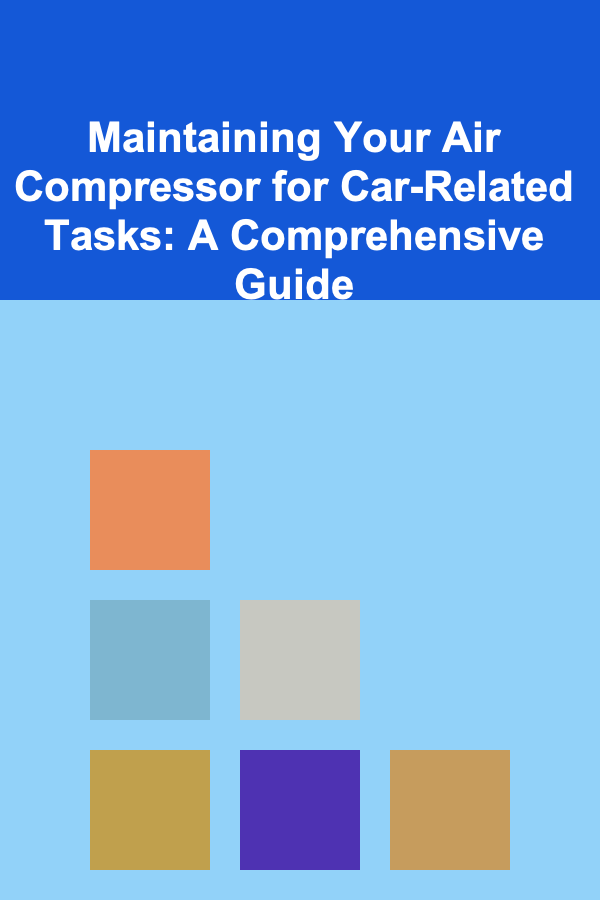
Maintaining Your Air Compressor for Car-Related Tasks: A Comprehensive Guide
ebook include PDF & Audio bundle (Micro Guide)
$12.99$6.99
Limited Time Offer! Order within the next:

An air compressor is an indispensable tool for any car enthusiast, home mechanic, or professional technician. From inflating tires to powering pneumatic tools, its versatility makes it a valuable asset in any garage or workshop. However, like any piece of equipment, air compressors require regular maintenance to ensure optimal performance, longevity, and safety. Neglecting maintenance can lead to decreased efficiency, costly repairs, and even dangerous situations. This comprehensive guide will walk you through the essential maintenance procedures for your air compressor, specifically tailored to car-related tasks, ensuring it remains a reliable workhorse for years to come.
Why Regular Maintenance is Crucial
Before diving into the specific maintenance tasks, it's important to understand why regular upkeep is so vital. Think of your air compressor as the heart of your pneumatic system. Just as a healthy heart is essential for a healthy body, a well-maintained compressor is crucial for efficient and reliable operation.
- Extended Lifespan: Consistent maintenance significantly prolongs the lifespan of your air compressor. Addressing small issues promptly prevents them from escalating into major problems that could lead to premature failure.
- Optimal Performance: A clean and properly functioning compressor delivers consistent air pressure and flow, ensuring that your pneumatic tools operate at their peak efficiency. This translates to faster completion times and better quality results.
- Increased Safety: Neglected compressors can pose safety hazards. Leaks, overheating, and malfunctioning pressure relief valves can lead to accidents and injuries. Regular maintenance helps identify and address these potential risks.
- Reduced Repair Costs: Preventative maintenance is far more cost-effective than repairing major damage. By identifying and fixing minor issues early on, you can avoid expensive repairs down the line.
- Energy Efficiency: A well-maintained compressor operates more efficiently, consuming less energy and reducing your electricity bill. Clogged filters and leaks force the motor to work harder, resulting in increased energy consumption.
Understanding Your Air Compressor: Types and Components
Air compressors come in various types, each with its own set of advantages and disadvantages. Understanding the type of compressor you own is essential for performing the correct maintenance procedures. For car-related tasks, the most common types are:
Types of Air Compressors
- Pancake Compressors: These are compact and lightweight, making them ideal for small jobs like inflating tires or powering airbrushes. They are typically oil-free, which reduces maintenance requirements but also limits their lifespan and continuous duty cycle.
- Hot Dog Compressors: Similar to pancake compressors but with a longer, cylindrical tank. They offer slightly more air storage capacity than pancake models, making them suitable for slightly larger tasks. Like pancake compressors, many are oil-free.
- Twin Stack Compressors: These compressors feature two vertically stacked tanks, providing significantly more air storage capacity than pancake or hot dog models. They are suitable for powering a wider range of pneumatic tools and are often used in home garages.
- Single-Stage Compressors: Single-stage compressors compress air in a single stroke, typically reaching a maximum pressure of around 125-135 PSI. They are suitable for most common car-related tasks, such as inflating tires, powering impact wrenches, and operating paint sprayers.
- Two-Stage Compressors: Two-stage compressors compress air in two stages, resulting in higher pressures (up to 175 PSI or more) and greater efficiency. They are ideal for heavy-duty applications and professional workshops.
- Oil-Free Compressors: These compressors use permanently lubricated parts or alternative technologies (like diaphragm pumps) and do not require oil changes. They are generally lower maintenance but tend to be noisier and may have a shorter lifespan than oil-lubricated models.
- Oil-Lubricated Compressors: These compressors use oil to lubricate the internal components, reducing friction and heat. They typically last longer and are quieter than oil-free models, but require regular oil changes.
Key Components of an Air Compressor
Regardless of the type, most air compressors share similar key components:
- Motor: The motor drives the compressor pump, providing the power to compress the air.
- Pump: The pump is the heart of the compressor, responsible for compressing the air. It consists of pistons, cylinders, valves, and connecting rods.
- Tank: The tank stores the compressed air, providing a reservoir for immediate use.
- Pressure Switch: The pressure switch automatically turns the motor on and off to maintain the desired pressure in the tank.
- Pressure Relief Valve: The pressure relief valve is a safety device that automatically releases air if the pressure in the tank exceeds a safe limit.
- Intake Filter: The intake filter prevents dust and debris from entering the pump, protecting the internal components.
- Air Outlet: The air outlet provides a connection point for air hoses and pneumatic tools.
- Drain Valve: The drain valve is located at the bottom of the tank and is used to drain accumulated moisture.
- Regulator: The regulator controls the output air pressure, allowing you to adjust the pressure to suit the specific tool or task.
- Gauge: Gauges display the air pressure in the tank and the output pressure set by the regulator.
Essential Maintenance Procedures
Now, let's delve into the specific maintenance procedures that you should perform regularly to keep your air compressor in top condition. Frequency will depend on the usage, environment, and manufacturer's recommendations.
1. Draining the Tank: A Daily Necessity
Condensation is a natural byproduct of compressing air. As warm, moist air enters the compressor, it cools down within the tank, causing water vapor to condense into liquid. This water accumulates at the bottom of the tank and can cause several problems:
- Rust and Corrosion: Water can corrode the inside of the tank, weakening its structure and potentially leading to leaks or even catastrophic failure.
- Reduced Air Capacity: Water takes up space in the tank, reducing the amount of compressed air that can be stored.
- Damage to Pneumatic Tools: Water can travel through the air lines and damage your pneumatic tools, causing them to malfunction or fail prematurely. It can also interfere with paint spraying, causing fisheyes or other imperfections.
How to Drain the Tank:
- Turn off the compressor and disconnect it from the power source. This is a critical safety precaution.
- Release the air pressure from the tank. You can do this by opening the drain valve slowly. Some compressors have a separate bleed valve to release pressure.
- Locate the drain valve at the bottom of the tank. It's usually a small valve that can be opened by turning it counterclockwise.
- Place a container underneath the drain valve to catch the water. Be prepared for a surprising amount of water to come out.
- Open the drain valve completely and allow all the water to drain out. This may take a few minutes. Tilting the compressor slightly can help remove stubborn water.
- Close the drain valve tightly after all the water has been drained. Ensure it's properly sealed to prevent air leaks.
Frequency: Ideally, drain the tank every time you use the compressor, especially if you live in a humid environment. At a minimum, drain it weekly. Think of it as a routine part of using the compressor, like checking the oil in your car.
2. Checking and Changing the Air Filter: Protecting the Pump
The air filter prevents dust, dirt, and debris from entering the compressor pump. These contaminants can cause significant damage to the internal components, leading to reduced efficiency, increased wear, and premature failure. A clogged or dirty air filter restricts airflow, forcing the motor to work harder, which can lead to overheating and increased energy consumption.
How to Check and Change the Air Filter:
- Locate the air filter. It's usually located on the compressor pump, often in a small housing. Consult your owner's manual if you're unsure of its location.
- Inspect the filter. Check for dirt, dust, and debris. A heavily soiled filter will be visibly dirty.
- Remove the filter. Most filters are easily removed by unscrewing a cap or removing a retaining clip.
- Clean the filter (if reusable). Some air filters are reusable and can be cleaned with compressed air or mild soap and water. Allow the filter to dry completely before reinstalling it. Note: Not all filters are reusable. Check your manual.
- Replace the filter (if disposable). If the filter is heavily soiled or damaged, replace it with a new one of the correct size and type.
- Reinstall the filter. Ensure the filter is properly seated and the housing is securely closed.
Frequency: Check the air filter at least every month, and more frequently if you use the compressor in a dusty environment. Replace the filter every 3-6 months, or as recommended by the manufacturer.
3. Checking and Changing the Oil (for Oil-Lubricated Compressors): Maintaining Lubrication
Oil-lubricated air compressors rely on oil to lubricate the internal components, reducing friction and heat. Over time, the oil can become contaminated with dirt, moisture, and metal particles, reducing its lubricating properties. This can lead to increased wear, overheating, and premature failure of the compressor pump. Using the wrong type of oil can also damage the compressor.
How to Check and Change the Oil:
- Locate the oil fill cap and dipstick (if equipped). The oil fill cap is usually located on the compressor pump. Some compressors have a dipstick to check the oil level.
- Check the oil level. If your compressor has a dipstick, remove it and wipe it clean. Reinsert the dipstick completely, then remove it again. The oil level should be between the "min" and "max" marks on the dipstick.
- Check the oil condition. The oil should be clean and clear. If it's dark, dirty, or milky, it's time to change it.
- Drain the old oil. Locate the drain plug on the compressor pump. Place a container underneath the drain plug to catch the old oil. Remove the drain plug and allow all the oil to drain out completely.
- Replace the drain plug. Ensure the drain plug is properly tightened to prevent leaks.
- Fill the compressor with new oil. Use the correct type and amount of oil as specified in your owner's manual. Overfilling can be as damaging as underfilling.
- Check the oil level again. Ensure the oil level is between the "min" and "max" marks on the dipstick (if equipped).
Frequency: Check the oil level and condition every month. Change the oil every 3-6 months, or as recommended by the manufacturer. Use the recommended type of oil for your compressor. Consult your owner's manual for specific recommendations.
4. Inspecting Hoses and Fittings: Preventing Leaks and Ensuring Safety
Air hoses and fittings are essential for connecting your compressor to your pneumatic tools. Leaks in hoses or fittings can reduce air pressure, decrease tool performance, and waste energy. Damaged hoses can also pose a safety hazard, as they can burst under pressure.
How to Inspect Hoses and Fittings:
- Visually inspect the hoses for cracks, cuts, abrasions, or bulges. Pay close attention to the areas near the fittings, as these are common points of failure.
- Check the fittings for leaks. You can use a soapy water solution to check for leaks. Apply the solution to the fittings and look for bubbles.
- Inspect the hose connections for tightness. Ensure the fittings are securely tightened to prevent leaks.
- Replace any damaged hoses or fittings immediately. Do not attempt to repair damaged hoses, as this can be dangerous.
Frequency: Inspect hoses and fittings before each use. Replace damaged components immediately.
5. Checking the Pressure Relief Valve: Ensuring Safety
The pressure relief valve is a crucial safety device that prevents the tank from over-pressurizing. If the pressure switch fails, the pressure relief valve will automatically release air to prevent a potentially dangerous explosion. A malfunctioning pressure relief valve can compromise the safety of your compressor.
How to Check the Pressure Relief Valve:
- Locate the pressure relief valve. It's usually located on the tank.
- Manually test the valve. Carefully pull the ring or lever on the valve to release some air. Be prepared for a loud hissing sound.
- Ensure the valve reseals properly. After releasing the lever or ring, the valve should reseal tightly. If it continues to leak, it needs to be replaced.
Frequency: Test the pressure relief valve every month. Replace the valve if it's not functioning correctly.
6. Cleaning the Compressor: Maintaining Appearance and Functionality
Keeping your air compressor clean not only improves its appearance but also helps prevent overheating and corrosion. Dust and dirt can accumulate on the motor and pump, reducing their efficiency and lifespan.
How to Clean the Compressor:
- Disconnect the compressor from the power source.
- Use a vacuum cleaner or compressed air to remove dust and dirt from the motor, pump, and tank.
- Wipe down the exterior surfaces with a damp cloth.
- Avoid using harsh chemicals or solvents, as these can damage the compressor's finish.
Frequency: Clean the compressor every month, or more frequently if you use it in a dusty environment.
7. Checking the Belt (for Belt-Driven Compressors): Ensuring Proper Power Transmission
Belt-driven air compressors use a belt to transmit power from the motor to the pump. A worn or loose belt can slip, reducing the efficiency of the compressor and potentially damaging the motor or pump.
How to Check the Belt:
- Inspect the belt for cracks, wear, or fraying.
- Check the belt tension. The belt should have some slack, but not too much. You should be able to press down on the belt with your finger and deflect it slightly.
- Adjust the belt tension if necessary. Most belt-driven compressors have an adjustment mechanism to tighten or loosen the belt. Consult your owner's manual for specific instructions.
- Replace the belt if it's worn or damaged.
Frequency: Check the belt every month. Replace the belt as needed.
8. Addressing Specific Car-Related Tasks
When using your air compressor for car-related tasks, consider these specific maintenance points:
- Tire Inflation: Ensure the air chuck is clean and in good condition to prevent leaks when inflating tires. Calibrate your tire pressure gauge regularly for accurate readings.
- Pneumatic Tools (Impact Wrenches, Ratchets, etc.): Use an inline oiler to lubricate your pneumatic tools properly. This extends their lifespan and ensures optimal performance. Check and refill the oiler regularly.
- Paint Spraying: Use an inline air dryer and filter to remove moisture and contaminants from the air before it reaches your paint gun. This is crucial for achieving a smooth, professional finish. Clean the filter regularly. A desiccant dryer is also a good investment, especially in humid climates.
- Sandblasting: Sandblasting requires a high volume of air. Ensure your compressor is adequately sized for the task. Also, be extra diligent about draining the tank, as sandblasting can introduce a significant amount of moisture into the system. Consider a dedicated air dryer for sandblasting.
Troubleshooting Common Issues
Even with regular maintenance, you may encounter occasional issues with your air compressor. Here are some common problems and their potential solutions:
- Compressor won't start:
- Check the power cord and outlet.
- Check the pressure switch setting.
- Check the motor for overheating.
- Check the overload protector (if equipped).
- Compressor runs but doesn't build pressure:
- Check for leaks in the hoses, fittings, or tank.
- Check the air filter for clogging.
- Check the pump for damage.
- Check the check valve.
- Compressor builds pressure slowly:
- Check the air filter for clogging.
- Check for leaks.
- The compressor may be undersized for the task.
- Compressor is noisy:
- Check for loose parts.
- Check the belt for wear (if belt-driven).
- Check the pump for damage.
- Compressor leaks air:
- Check the hoses, fittings, and tank for leaks.
- Check the drain valve.
- Check the pressure relief valve.
If you're unable to resolve a problem yourself, consult a qualified technician.
Safety Precautions
Working with compressed air can be dangerous if proper safety precautions are not followed. Always adhere to these safety guidelines:
- Always wear safety glasses when working with compressed air.
- Never point an air nozzle at yourself or others.
- Never exceed the maximum pressure rating of your air tools or accessories.
- Always disconnect the compressor from the power source before performing any maintenance or repairs.
- Never attempt to repair a pressurized tank.
- Be aware of the noise level of the compressor and wear hearing protection if necessary.
- Store the compressor in a well-ventilated area.
- Follow all manufacturer's instructions and safety guidelines.
Conclusion: Investing in Longevity and Performance
Maintaining your air compressor is an investment in its longevity, performance, and safety. By following the simple maintenance procedures outlined in this guide, you can ensure that your compressor remains a reliable and valuable tool for all your car-related tasks. Remember to consult your owner's manual for specific recommendations and maintenance schedules. A little preventative maintenance goes a long way in avoiding costly repairs and ensuring years of trouble-free operation. So, take the time to care for your air compressor, and it will reward you with years of dependable service, making your automotive projects easier and more enjoyable.

How to Add Texture and Warmth to Your Home on a Budget
Read More
How to Master Time Management for Small Business Owners
Read More
How to Soundproof a Nursery for Better Baby Sleep
Read More
How to Develop Blockchain for Royalty Distribution Systems
Read More
How to Debunk Any Conspiracy Theory: A Skeptic's Handbook
Read More
How To Create a Minimalist Kitchen Pantry
Read MoreOther Products

How to Add Texture and Warmth to Your Home on a Budget
Read More
How to Master Time Management for Small Business Owners
Read More
How to Soundproof a Nursery for Better Baby Sleep
Read More
How to Develop Blockchain for Royalty Distribution Systems
Read More
How to Debunk Any Conspiracy Theory: A Skeptic's Handbook
Read More